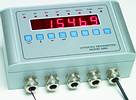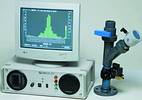

Some believed that the rand was set to continue in its downward slide. Few (it seemed), considered the stabilising effect caused by changes in the balance of trade. As the rand continued to drop, exporting local products would become more and more profitable, more dollars were coming into the country than before. Some of us were not surprised when the rand turned around and began gaining on the dollar. Whatever the reasons, the rand’s fall, followed by its recent rise, has naturally influenced the profitability of SA’s exporters. In this article, Maurice McDowell takes a look at the achievements and experiences of the country’s instrumentation and control leaders during this period. – Ed
State-of-the-art software, particularly scada, is essential to the effective and efficient operation of any plant or distributed operating system. Adroit Technologies (Adroit) of Randburg entered this highly competitive field of process control software solutions in 1982. This timing was soundly based as major international players were only getting off the starting blocks and this allowed the company to develop the only truly local scada system which is both world class and is internationally competitive in both advanced features and cost. Software development is a field where technology is continually changing and Adroit has invested appropriately here to keep on par with larger international competitors.
In December 2002 it released its latest Version 5.0 software, having won the SPII 2000 Award for Industrial Innovation for a previous release, namely Adroit 4.2. This scada system is used by local high profile companies such as the SA Mint and Tubatse Ferrochrome, while beyond our borders clients include the Orapa Diamond Mine in Botswana and the UK's National Electricity Grid. Adroit scada software has also been used to automate the French A14 urban toll motorway and the UK's Ushers Brewery. The latter customer commented that "they chose Adroit because of the object design, ease of use, and the first class support provided by the Adroit UK office".
Adroit is relatively impervious to the rand/dollar exchange rate as the input is its own local engineering skills and intellectual property. With some 40% of the company's revenue being derived from export this is fortuitous and in fact the dollar pricing of the products has not changed in the last three years providing price stability for the customer base. The MD, Dave Wibberley, believes that the strong rand is currently beneficial to the company as international travel is cheap and it is allowing the company to build stronger relationships with distributors and customers. The only downside seen is that when the R/$ is bad the country faces renewed pressure on its intellectual capacity with the lure of foreign currency earnings accelerating the brain drain.
Another company with a long history of local achievements in the I&C field is Instrotech, which was formed in 1981 by the well-known Dave Howcroft with focus being to create high quality process control instrumentation and industrial electronics. Instrotech was followed by the establishment of Digital Process Measurement in 1989 where Dave was partnered by the late Peter Krause. Instrotech's own product range includes digital panel meters (AC/DC), temperature transmitters, signal isolators, power supplies and load cell amplifiers. One of the company's major successes was the development in 1984 of a computer-based acoustic leak detection system for use on large boilers. This system which makes use of Fast Fourier Transforms for generation of audio spectra which with computer analysis can be used to predict where the leak is likely to be, with up to 32 specially designed microphones being used to monitor the combustion chamber. This system (the INSPECTA FFT) has been adopted by power stations in North America, Europe, India, Japan, China and Australia and it is used for the early detection of leaks to reduce downtime and prevent consequential damage.

Dave Howcroft was not available for comment as he was overseas on business but it is expected that the uniqueness of the INSPECTA FFT system would allow it to still be highly competitive in international markets. As with other respondents it is expected that margins will be pushed in terms of other devices.
One young company that has had amazing success is LaserM, which pioneered the use of eye-safe lasers in 1993 to determine level of liquids and solids. Lasers have for many years been used in military rangefinders but the industrial advantages had not been exploited. The laser meters manufactured by LaserM use the same principle: A short laser pulse is emitted by the device and a receiver determines the time of return of the reflected beam. As the speed of light is known, the distance to a liquid or solid can be very accurately and rapidly determined.

The current product line includes the LM4C, LM02 and the recently launched PIXIE+. Between these versions distances from as little as 10 mm up to 500 m is covered, with the resolution for the latter being 0,1%. With the exception of the electronic components and the laser diode the laser meters have a high local content (including the optics). The devices are used for level sensing, height control, positioning and movement detection.

A relationship established with Ktek Corporation in the USA has resulted in the company being able to open the doors to the difficult North American market. Together with deliveries to Europe the company has increased its exports by 38% over the last 12 months and it received the SME Export Award for 2001/2002 for its exponential increase in exports. LaserM believes that its products are competitively priced in both the local and international markets and it partly attributes its success to the fact that it has invested in continuous improvement (engineering effort) to the product line to meet the needs of its customers. Despite the success of its export drive the MD, James Portman, says that LaserM is first and foremost a proud South African company and his objective is to see it become the dominant level-control company in this country.
Another local manufacturer supporting the international I&C industry is KAB Instruments (KAB). With more than 20 years of expertise in the field of ultrasonic measurement KAB has applied this to the design and manufacture of a wide range of products for level measurement, open channel flow and blocked chute detection. The company also manufactures the required transducers and offers level measurement in the range from 5 to 60 m. Ultrasonic measurement of level is a non-contact process and can be used for a wide range of solids and fluids. KAB instrumentation is used in industries that include mining, steel, petrochemical, paper and pulp as well as food and beverage. To complement its range of instrumentation the company has developed its own software package called KABScope. Loaded on a PC or laptop this generates an on-screen oscilloscope and enables users to rapidly program the devices and to perform fault finding.
While KAB has a large local market share for its products it still exports between 30 and 40% of its production with CE approval in Europe leading to entry into the tough North American market. The strengthening rand has effectively eroded the profit margins once achieved by the company as it has retained the large incentive discounts offered to its overseas distributors. Another difficulty being experienced is that many of the overseas suppliers of components have also increased their costs, blaming such factors as the expense of forward cover with a seemingly unstoppable upward moving rand.
The Lodox digital X-ray imaging system is a unique South African invention driven by the need of De Beers to protect its diamond mining activities and to prevent workers from removing stones at the end of their shift. The problem the company faced was that these diamonds could be located anywhere on the body of the worker, they could be hidden in his shoes, may have been swallowed or inserted into a body orifice such as the mouth or ear.
Having made the decision to follow the X-ray route the problems faced by De Beers DRL seemed insurmountable. A full body scan was required and the accumulated radiation dose to which the worker would be exposed had to be less than that allowed under occupational health regulations over a one year period. To be effective a 100% sample of staff exiting the mine was required that implied that the time taken per scan was critical. Without going into detail DRL made use of image intensification devices together with sophisticated digital processing to make the system work within the required parameters. Installed at De Beers mining sites the research team looked at other applications and the first one exploited was medical imaging. A trial system was installed at Groote Schuur and soon proved invaluable. A trauma case, for example, may have multiple body fractures. A rapid full body X-ray allows the medical team to establish the full amount of damage and to plan life-saving multiple surgery.
The commercialisation and marketing of X-ray systems is, of course, not core to the business of De Beers and a venture company, Lodox Systems, was established with the equity partners being the IDC, Netcare and De Beers. The inventor of the system, Herman Potgieter was then installed as CEO of Lodox, which has since set up a fully-owned subsidiary, Lodox Systems, North America. The commercialised product, known as Statscan, has since received FDA approval.
In a truly 'proudly South African' initiative Lodox tied up with Adroit Technologies which have provided its technologically advanced Version 5.0 software as the user interface. Adroit incorporated some of the special requirements of Lodox into the new scada release. The Statscan is intended to ensure that trauma patients can be stabilised within the so-called 'golden hour' and it is perhaps edifying that its first installation was in a US Trauma Centre named after the doctor that coined this term, namely R. Adams Cowley. Several other export orders for the system have been received but Lodox is addressing some minor teething problems before acting on these. The main problem encountered is that the average trauma patient in the US is more obese than those encountered in the local trials.
The Statscan system has a list price in the region of $400 000 and as a result of the fact that a high percentage of the input costs are for imported devices, Herman Potgieter does not see the rand exchange value as critical to the success of the company which is of course offering a very unique product.
The initial collapse of the rand certainly worked in favour of exporters where there was high local content in terms of cost such as labour input. However this had to be balanced against the fact that essentially all electronic components and sub-systems are imported, resulting in this portion having a higher rand cost. Overall exporters found themselves more competitive in terms of dollar costs but many entered into longer term contracts based on this (at dollar rates). The recovery of the rand in recent months has thus seen profit margins seriously eroded and a longer term strong rand will no doubt see reduced exports where the market is highly competitive. While we might not see the rand return to where it was 18 months ago exporters would prefer some longer term stability.
What must be remembered is the cost of the engineering effort that goes into a system or device. Engineers come cheap in this country with their remuneration packages being about a third of that of their counterparts in Europe. Where a large engineering effort is required to develop hardware and/or software, companies in this country should be able to keep themselves competitive even when the rand is strong. Whether we like it or not our unskilled labour is not cheap and is not competitive in cost or quality with technology. Companies in the electronics sector have maintained their competitive position through massive continued investment in automation of for example surface mount technology. In the automotive industry the incentives provided through the MIPD cannot be ignored, and similar initiatives by the DTI could benefit other local exporters, including those in the I&C sector.
Exporters of manufactured goods (with the exception of the motor industry) suffered from the removal of GEIS some years ago, one argument being that industry should become more competitive through increased productivity rather than relying on government subsidies. While exporters did experience a heyday during the period of the rand weakness they are now seriously under pressure in many instances to be competitive in foreign currency costs. A double blow for local manufacturers that have a solid local market is that imported competitive products are becoming cheaper so even local market share could be eroded. The local market itself is not in that healthy a state as even economy leaders like the gold mining industry is threatening job cuts and cutting back on capital expenditure while putting new ventures on hold.
Dr Maurice McDowell, has many years' experience as a technical journalist, editor, business manager and research scientist. His third party analyses of world-class companies and processes, as well as his insight into industry and technology trends are well respected.

© Technews Publishing (Pty) Ltd | All Rights Reserved